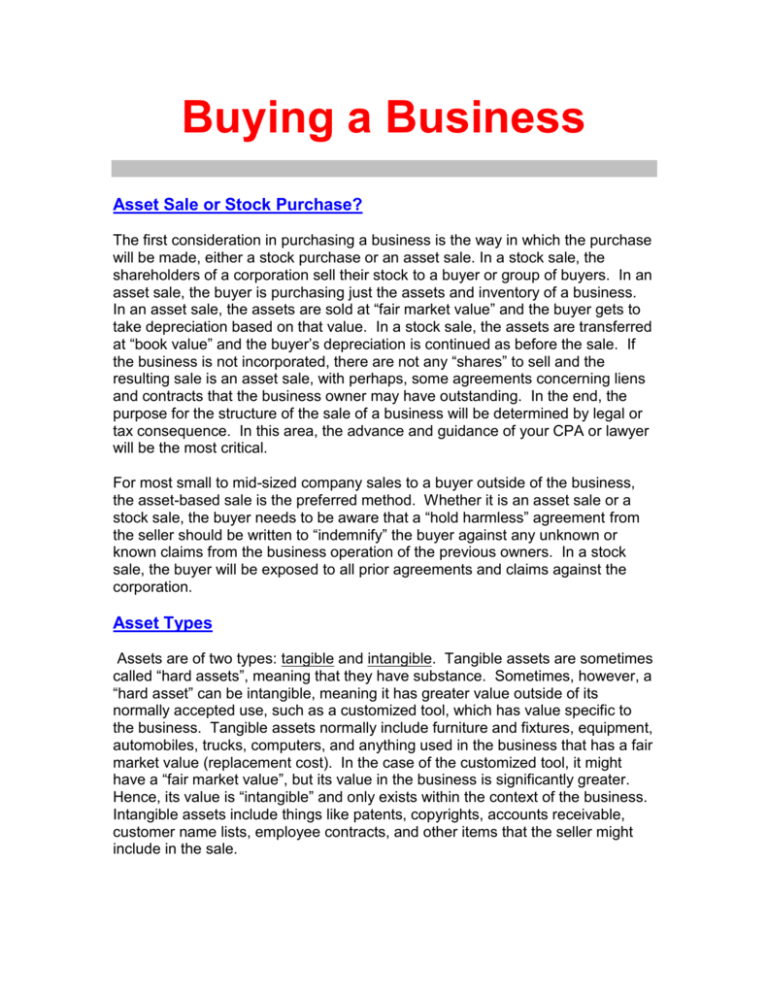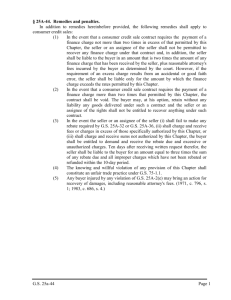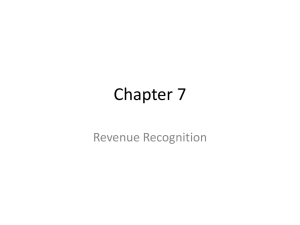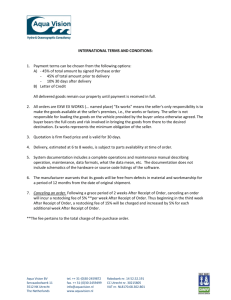Buying a Business
advertisement

Buying a Business Asset Sale or Stock Purchase? The first consideration in purchasing a business is the way in which the purchase will be made, either a stock purchase or an asset sale. In a stock sale, the shareholders of a corporation sell their stock to a buyer or group of buyers. In an asset sale, the buyer is purchasing just the assets and inventory of a business. In an asset sale, the assets are sold at “fair market value” and the buyer gets to take depreciation based on that value. In a stock sale, the assets are transferred at “book value” and the buyer’s depreciation is continued as before the sale. If the business is not incorporated, there are not any “shares” to sell and the resulting sale is an asset sale, with perhaps, some agreements concerning liens and contracts that the business owner may have outstanding. In the end, the purpose for the structure of the sale of a business will be determined by legal or tax consequence. In this area, the advance and guidance of your CPA or lawyer will be the most critical. For most small to mid-sized company sales to a buyer outside of the business, the asset-based sale is the preferred method. Whether it is an asset sale or a stock sale, the buyer needs to be aware that a “hold harmless” agreement from the seller should be written to “indemnify” the buyer against any unknown or known claims from the business operation of the previous owners. In a stock sale, the buyer will be exposed to all prior agreements and claims against the corporation. Asset Types Assets are of two types: tangible and intangible. Tangible assets are sometimes called “hard assets”, meaning that they have substance. Sometimes, however, a “hard asset” can be intangible, meaning it has greater value outside of its normally accepted use, such as a customized tool, which has value specific to the business. Tangible assets normally include furniture and fixtures, equipment, automobiles, trucks, computers, and anything used in the business that has a fair market value (replacement cost). In the case of the customized tool, it might have a “fair market value”, but its value in the business is significantly greater. Hence, its value is “intangible” and only exists within the context of the business. Intangible assets include things like patents, copyrights, accounts receivable, customer name lists, employee contracts, and other items that the seller might include in the sale. In an asset sale you can be buying both with and/or without liens. In a corporation, the corporation is left to the seller. In either a stock sale or an asset sale, you will need to identify the assets and determine whatever value they provide to the business. The buyer must be able to review a list of all tangible assets and their associated fair market value. Intangible assets will have business specific value. For example, the customer list might be of more value to a men’s clothier than it would be to a large lot retailer. The accounts receivable might have value if current, within 30 days for example, but might be close to worthless if over 90 days. The buyer and the seller must arrive at an agreement as to how to value these intangibles. If you are seeking bank financing, the intangible assets will usually have little value in securing a loan. Selling Price? The multiple methods of business evaluation to determine a selling price are: 1. Discretionary earnings method (See Seller’s Discretionary Earnings below) 2. Asset/earnings method, adds replacement costs of tangible assets plus Seller’s Discretionary Earnings to arrive at a suggested selling price. Inventory is minimal or non-existent. 3. Capitalization of earnings requires a “rate of return” or “Cap Rate” the buyer feels he needs to justify the purchase. This method is more useful for larger purchases. The method is expressed as “Capitalized Value = Earnings/ ROI (expressed as a decimal)”. The key here is to determine the appropriate “ROI” (rate of return) that would be characteristic of the industry, using sources such as Dun & Bradstreet or Worldata, Inc. In some cases, the appraiser derives an ROI from his own experience. The sales price is then the Capitalization Value plus the replacement cost of the tangible assets plus inventory. 4. Excess earnings method places a “value” on Goodwill. The concept is the buyer is entitled to a fair return on his investment in the tangible assets and everything above that is “excess earnings”. Again, the technique requires a capitalization rate or rate of return on the investment. Inventory will have little or minimal value. 5. “Carry Back” or Pay Back method is basically the same as Discretionary Earnings method, except the buyer’s down payment is derived by subtracting the annual total of loan payments times the number of years carried from the sales price. This method does not have a relationship to “value” as the sales price is the result of the financing that can be “afforded” from the earnings and what the buyer can pay in the down payment. This method would be used in a small business purchase with Seller financing. 6. Market Guidelines are derived from survey data of many financial closings and industry organizations that collect this data. Most business appraisers will have “guidelines” that they develop, usually industry specific as they gain experience. Most of these sources are fee or proprietary services. 7. Rules of Thumb can be found in a publication called The Business Reference Guide, Business Book Press, Tom West, editor. Only available from the publisher at www.BusinessBookPress.com. Whatever method is used, once a value is agreed upon, the difference between the fair market value of the tangible assets and the total value (selling price) is assigned to the intangible assets and is usually called “goodwill”. A detailed discussion of each method is beyond the scope of this paper and is best left to the reader’s own research or his/her CPA. Additionally, business appraisal services exist specifically to provide these valuations. They will draw upon their own data sources of comparable business sales and industry accepted “rules of thumb”. A business appraisal should provide at least three methodologies to arrive at a reconciliation of value, of which one could be a comparable sales approach. Having access to the comparable sales data is usually a limiting factor for most accounting firms who do not perform business evaluations as a normal service. Seller’s Discretionary Earnings For small businesses (below one million in annual sales), the discretionary earnings method is useful. If nothing else, it determines whether or not the buyer can afford to consider the possible purchase of the business. Also called the Seller’s Discretionary Earnings (SDE) method, you first determine the actual earnings in the typical or current year. Monies spent for items such as health insurance, interest on loans, personal car leases, depreciation, etc. are called “add backs”, and are added to the income that the seller has made in the business. In a case where the seller might have invested a sizeable amount of operating capital in an improvement, it might also be added back. The business’ share of tax withholding on the seller’s salary is also added back. The exercise is to determine the total money benefit the seller has derived from owning the business in the most current or typical year. The resulting amount is called the “Seller’s Discretionary Earnings” or SDE. From the SDE, the buyer needs to deduct his/her owned planned salary for the year, health insurance cost, auto payment, or any expense that he would require for life style. The amount left is the money he will have to make payments for a loan to purchase the business. This money will also have to cover any improvements such as a new advertising campaign, a new expansion, or a change in management. If the resulting amount is not sufficient to cover the loan payments or the expansions, the buyer will need to make adjustments in his business plan. Such adjustments might include a renegotiation of the selling price, or a change in the terms of the loan or the seller’s participation in the financing. Remember, as a buyer, you only want to consider “provable” or documented money amounts. As a seller, you must have your financial records and contracts in order and be able to “prove” any sources of cash that are not documented. The above process is called “Reconstruction of the Income and Expense Statement”. Most buyers of small businesses are purchasing a job that provides for their family. If the selling price is too high, the necessary financing needed to purchase the business will not be covered by the business cash flow. Factors that can make a particular sales price more attractive would be: (1) Seller financing; or (2) Seller participation in the down payment; or (3) Potential for new growth that will add immediate new income, in that order. SCORE can be a valuable source for assistance in your evaluations for buying or selling a business. Many of our counselors have bought and sold their own businesses and have learned that too much advice is never enough. What is covered above is just the beginning to a long and diligent process, which will require assistance from many sources. Reference: Strategies for Buying or Selling a Business, by Russell L. Brown, The Business Book Press, RDS Associates, Inc. Niantic, CT 06357, copyright 2002. The ideas presented here are found in his work and expanded in much greater detail.







